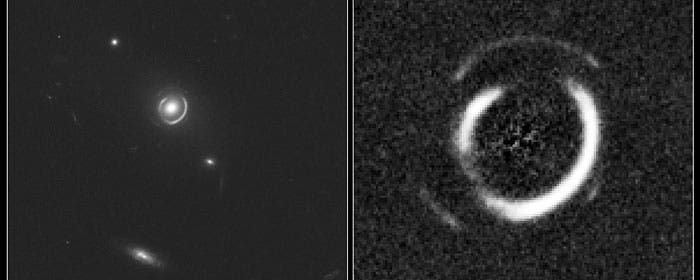
Hubble just never ceases to surprise. The latest astronomical find discovered using the ever resourceful space telescope is a never before encountered double ring pattern known as an Einstein ring. This very rare pattern is the result of a peculiar optical alignment in which three galaxies are perfectly aligned with each other, like beads on a string. The occurrence isn’t just a silly optical trick in space – studying it, astronomers can learn more about dark matter and dark energy, and even the curvature of the Universe.
The phenomenon that gave rise to this peculiar observation is known as gravitational lensing, in which the light emitted by a galaxy in the background gets bent by the gravitational pull of a massive galaxy in the foreground. In our case, one could say we have a double gravitational lens on our hands since a third massive galaxy lies in the foreground. When two galaxies are exactly lined up, the light gets twisted in such a fashion that it forms a shape that resembles a circle, called Einstein’s ring. When three of them are perfectly lined up, such as the case, two concentric rings form.
“Such stunning cosmic coincidences reveal so much about nature. Dark matter is not hidden to lensing,” added Leonidas Moustakas of the Jet Propulsion Laboratory in Pasadena, California, USA. “The elegance of this lens is trumped only by the secrets of nature that it reveals.“
The odds of such a phenomenon being observable from Earth’s vantage point are so dim, that the discovery can be considered nothing short of jackpot! In fact, the team of astronomers led by Raphael Gavazzi and Tommaso Treu of the University of California, Santa Barbara were extremely lucky to spot it in the first place. SLACS team member Adam Bolton of the University of Hawaii’s Institute for Astronomy in Honolulu first identified the lens in the Sloan Digital Sky Survey (SDSS). “The original signature that led us to this discovery was a mere 500 photons (particles of light) hidden among 500,000 other photons in the SDSS spectrum of the foreground galaxy,” commented Bolton.
The geometry of the two rings allowed the researchers to establish the mass of the middle galaxy precisely to be a value of 1 billion solar masses – a dwarf galaxy. This is actually the first time a dwarf galaxy’s mass was measured at cosmological distance. The comparative radius of the rings could also be used to provide an independent measure of the curvature of space by gravity.
The results were reported at the 211th meeting of the American Astronomical Society in Austin, Texas, USA. A paper has been submitted to The Astrophysical Journal.
[source]
Was this helpful?



